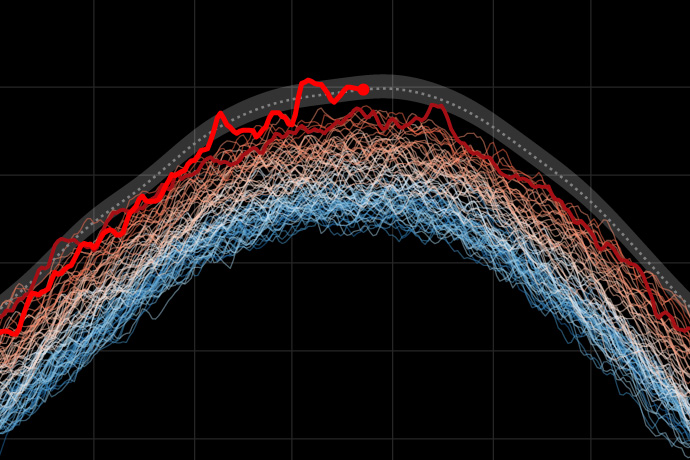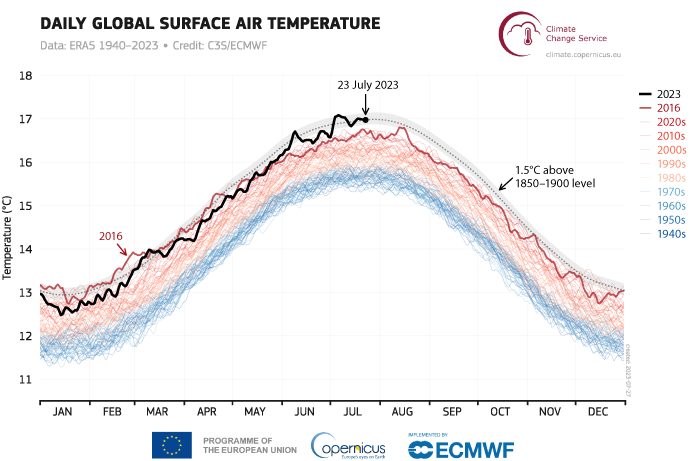

According to ERA5 data from the EU-funded Copernicus Climate Change Service (C3S) implemented by ECMWF, the first three weeks of July have been the warmest three-week period on record and the month is on track to be the hottest on record, a press release issued by C3S and the World Meteorological Organization (WMO) says.
The high temperatures have been related to heatwaves in large parts of North America, Asia and Europe, which, along with wildfires in countries including Canada and Greece, have had major impacts on people’s health, the environment and economies.
On 6 July, the daily average global mean surface air temperature surpassed the record set in August 2016, making it the hottest day on record, with 5 July and 7 July shortly behind. The first three weeks of July have been the warmest three-week period on record. Global mean temperature temporarily exceeded the 1.5° Celsius threshold above the preindustrial level during the first and third week of the month (within observational error). Since May, the average sea-surface temperature from 60°S to 60°N has been well above previously observed values for the time of the year, contributing to the exceptionally warm July.
It is extremely likely that July 2023 will be the hottest July and also the hottest month on record, following on from the hottest June on record. According to ERA5 data, the previous hottest July and month on record was July 2019. Complete ERA5 data for July will be available and published by C3S in their upcoming monthly bulletin on 8 August.

Global daily surface air temperature (°C) from 1 January 1940 to 23 July 2023, plotted as time series for each year. 2023 and 2016 are shown with thick lines shaded in bright red and dark red, respectively. Other years are shown with thin lines and shaded according to the decade, from blue (1940s) to brick red (2020s). The dotted line and grey envelope represent the 1.5°C threshold above preindustrial level (1850–1900) and its uncertainty. Data: ERA5. Credit: C3S/ECMWF.
Carlo Buontempo, Director of the Copernicus Climate Change Service (C3S) at ECMWF, commented: “Record-breaking temperatures are part of the trend of drastic increases in global temperatures. Anthropogenic emissions are ultimately the main driver of these rising temperatures.” He added: “July’s record is unlikely to remain isolated this year, C3S’ seasonal forecasts indicate that over land areas temperatures are likely to be well above average, exceeding the 80th percentile of climatology for the time of year.”
“The extreme weather which has affected many millions of people in July is unfortunately the harsh reality of climate change and a foretaste of the future,” said World Meteorological Organization’s Secretary-General Prof. Petteri Taalas. “The need to reduce greenhouse gas emissions is more urgent than ever before. Climate action is not a luxury but a must.”
The WMO predicts that there is a 98% likelihood that at least one of the next five years will be the warmest on record, and there is a 66% chance of temporarily exceeding 1.5°C above the 1850–1900 average for at least one of the five years.
This does not mean that we will permanently exceed the 1.5°C level specified in the Paris Agreement, which refers to long-term warming over many years.
More details can be found in an article published on the C3S website.
C3S, implemented by the European Centre for Medium-Range Weather Forecasts (ECMWF) on behalf of the European Commission, routinely monitors climate and has also been closely following the recent development of global air and sea-surface temperatures.
The World Meteorological Organization (WMO) consolidates data from C3S and five other international datasets for its climate monitoring activities and its State of the Climate reports.
Top image credit: C3S/ECMWF
